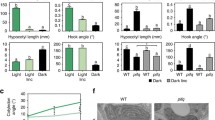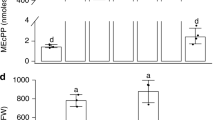Abstract
The PsPK3 and PsPK5 genes of the garden pea encode protein-serine/threonine kinases whose catalytic domains are closely related to known signal transducing kinases from animals and fungi. The PsPK3 polypeptide is predicted to be located in the nucleus, whereas PsPK5 is a homologue of NPH1, the probable blue light receptor for phototropism from Arabidopsis. We found previously that when etiolated pea seedlings are illuminated with continuous white light, PsPK3 and PsPK5 transcript levels within apical buds decline substantially, reaching their minimum levels within one day of exposure to light. The role of light in regulating the expression of the PsPK3 and PsPK5 genes was investigated further. To gain insight into the rapidity with which expression changes, 6-day old, dark-grown pea seedlings were transferred to continuous white light, and PsPK3 and PsPK5 RNA levels monitored over the ensuing 24 h. While transcripts from the RbcS gene family increase, the PsPK3 and PsPK5 mRNAs decline rapidly to their minimum levels. PsPK5 mRNA declines 10-fold in ca. 2 h, whereas PsPK3 mRNA declines 4-fold in ca. 8 h. We used single pulses of light to elucidate which photoreceptor triggers the negative regulation of PsPK3 and PsPK5 gene expression. To assess phytochrome involvement, etiolated seedlings were treated with single pulses of red light, red followed by far-red light, or far-red light alone. RbcS induction by a red light pulse is reversible with a subsequent far-red light pulse, clearly showing that phytochrome mediates its induction. Likewise, RbcS expression is induced with a single pulse of blue light or a dichromatic pulse of red+blue light. However, none of these pulses trigger the PsPK3 and PsPK5 mRNA levels to decline. Given the lack of effectiveness of light pulses, etiolated seedlings were transferred to continuous light of three different qualities to determine the spectral sensitivity of PsPK3 and PsPK5 gene expression. Exposure to continuous red, continuous far-red, or continuous blue light causes the PsPK3 and PsPK5 mRNAs to decline and transcripts from the RbcS and Cab gene families to increase. One likely explanation is that phytochrome A mediates the responses of these genes to continuous far-red light. The effectiveness of continuous red light and blue light in triggering the reduction in PsPK3 and PsPK5 mRNA levels and the increase in RbcS and Cab mRNAs may imply the participation of additional phytochromes and/or cryptochromes. Thus, the PsPK3 and PsPK5 genes exhibit responsiveness to continuous light, but a lack of responsiveness to single light pulses that is unusual, and perhaps unique, among light-regulated genes.
Similar content being viewed by others
References
Abler ML, Green PJ: Control of mRNA stability in higher plants. Plant Mol Biol 32: 63–78 (1996).
Ahmad M, Cashmore AR: Seeing blue: the discovery of cryptochrome. Plant Mol Biol 30: 851–861 (1996).
Barnes A, Quaggio RB, Whitelam GC, Chua N-H: fhy1 de-fines a branch point in phytochrome A signal transduction pathways for gene expression. Plant J 10: 1155–1161 (1996).
Briggs WR, Mandoli DF, Shinkle JR, Kaufman LS, Watson JC, Thompson WF: Phytochrome regulation at the whole plant, physiological, and molecular levels. In: Columbetti G, Song PS (eds) Sensory Perception and Transduction in Aneural Systems, pp. 265–280. Plenum Press, New York (1985).
Broglie R, Bellemare G, Bartlett S, Chua N-H, Cashmore A: Cloned DNA sequences complementary to mRNAs encoding precusors to the small subunit of ribulose-1, 5-bisphosphate carboxylase and a chlorophyll a/b binding polypeptide. Proc Natl Acad Sci USA 78: 7304–7308 (1981).
Conley TR, Shih M-C: Effects of light and chloroplast functional state on expression of nuclear gene encoding chloroplast glyceraldehyde-3-phosphate dehydrogenase in long hypocotyl mutants (Hy) and wild-type Arabidopsis thaliana. Plant Physiol 108: 1013–1022 (1995).
Cosgrove DJ: Photomodulation of growth. In: Kendrick RE, Kronenberg GHM (eds) Photomorphogenesis in Plants, pp. 631–658. Kluwer Academic Publishers, Dordrecht, Netherlands (1994).
Datta N, Chen Y-R, Roux SJ: Phytochrome and calcium stimulation of protein phosphorylation in isolated pea nuclei. Biochem Biophys Res Comm 128: 1403–1408 (1985).
Gallo-Meagher M, Sowinski DA, Elliot RC, Thompson WF: Both internal and external regulatory elements control expression of the pea Fed-1 gene in transgenic tobacco seedlings. Plant Cell 4: 389–395 (1992).
Hamazato F, Shinomura T, Hanzawa H, Chory J, Furuya M: Fluence and wavelength requirements for Arabidopsis CAB gene induction by different phytochromes. Plant Physiol 115: 1533–1540 (1997)
Hanks SK, Hunter T: The eukaryotic protein kinase superfamily: kinase (catalytic) domain structure and function. FASEB J 9: 576–596 (1996).
Harter K, Kircher S, Frohnmeyer H, KrenzM, Nagy F, Schäfer E: Light-regulated modification and nuclear translocation of cytosolic G-box binding factors in parsley. Plant Cell 6: 545–559 (1994).
Holtorf H, Apel K: Transcripts of the two NADPH protochlorophyllide oxidoreductase genes PorA and PorB are differentially degraded in etiolated barley seedlings. Plant Mol Biol 31: 387–392 (1996).
Holtorf H, Reinbothe S, Reinbothe C, Bereza B, Apel K: Two routes of chlorophyllide synthesis that are differentially regulated by light in barley Hordeum vulgare L.). Proc Natl Acad Sci USA 92: 3254–3258 (1995).
Huala E, Oeller PW, Liscum E, Han I-S, Larsen E, Briggs WR: Arabidopsis NPH1: a protein kinase with a putative redox-sensing domain. Science 278: 2120–2123 (1997).
Karpinski S, Escobar C, Karpinska B, Creissen G, Mullineax PM: Photosynthetic electron transport regulates expression of cytosolic ascorbate peroxidase gene in Arabidopsis during excess light stress. Plant Cell 9: 627–640 (1997).
Kaufman LS, Briggs WR, Thompson WF: Phytochrome control of specific mRNA levels in developing pea buds. The presence of both very low fluence and low fluence responses. Plant Physiol 78: 388–393 (1985).
Kaufman LS, Thompson WF, Briggs WR: Different red light requirements for phytochrome-induced accumulation of Cab and RbcS RNA. Science 226: 1447–1449 (1984).
Kenigsbuch D, Tobin EM: A region of the Arabidopsis Lhcb1 3 promoter that binds CA-1 activity is essential for high expression and phytochrome regulation. Plant Physiol 108: 1023–1027 (1995).
Khanna R, Watson JC: cDNA sequence of PsPK3 (Accession No. U11553), a protein kinase homologue from Pisum sativum L. Plant Physiol 114: 1569 (1997).
Lin XL, Feng X-H, Watson JC: Differential accumulation of transcripts encoding protein kinase homologues in greening pea seedlings. Proc Natl Acad Sci USA 88: 6951–6955 (1991).
Lin XL, Watson JC: cDNA sequence of PsPK5, a protein kinase homologue from Pisum sativum L. Plant Physiol 100: 1072–1074 (1992).
Liscum E, Briggs WR: Mutations in the NPH1 locus of Arabidopsis disrupt the perception of photoropic stimuli. Plant Cell 7: 473–485 (1995).
Mancinelli AL: The physiology of phytochrome action. In: Kendrick RE, Kronenberg GHM (eds) Photomorphogenesis in Plants, pp. 211–269. Kluwer Academic Publishers, Dordrecht, Netherlands (1994).
Petracek ME, Dickey LF, Huber SC, Thompson WF: Lightregulated changes in abundance and polyribosome association of ferredoxin mRNA are dependent on photosynthesis. Plant Cell 9: 2291–2300 (1997).
Quail PH: Phytochrome genes and there expression. In: Kendrick R, Kronenberg G (eds) Photomorphogenesis in Plants, pp. 71–104. Kluwer Academic Publishers, Dordrecht, Netherlands (1994).
Quail PH, Boylan MT, Parks BM, Short TW, Xu Y, Wagner D: Phytochromes: photosensory perception and signal transduction. Science 268: 675–680 (1995).
Romero LC, Biswal B, Song P-S: Protein phosphorylation in isolated nuclei from etiolated Avena seedlings. Effects of red/far-red light and cholera toxin. FEBS Lett 282: 347–50 (1991).
Roux S: Signal transduction in phytochrome responses. In: Kendrick RE, Kronenberg GHM (eds) Photomorphogenesis in Plants, pp. 187–210. Kluwer Academic Publishers, Dordrecht, Netherlands (1994).
Sakamoto K, Nagatani A: Nuclear localization activity of phytochrome B. Plant J 10: 859–868 (1996).
Sambrook J, Fritsch EF, Maniatis T: Molecular Cloning: A Laboratory Manual, 2nd ed. Cold Spring Harbor Laboratory Press, Cold Spring Harbor, NY (1989).
Seeley KA, Byrne DH, Colbert JT: Red light-independent instability of oat phytochrome mRNA in vivo. Plant Cell 4: 29–38 (1992).
Senger H, Schmidt W: Diversity of photoreceptors. In: Kendrick R, Kronenberg G (eds) Photomorphogenesis in Plants, pp. 301–326. Kluwer Academic Publishers, Dordrecht, Netherlands (1994).
Short T, Briggs W: The transduction of blue light signals in higher plants. Annu Rev Plant Physiol Plant Mol Biol 45: 143–171 (1994).
Thompson WF, Everett M, Polans NO, Jorgensen RA, Palmer JD: Phytochrome control of RNA levels in developing pea and mung bean leaves. Planta 158: 487–500 (1983).
von Lintig J, Welsch R, Bonk M, Giuliano G, Batschauer A, Kleinig H: Light-dependent regulation of carotenoid biosynthesis occurs at the level of phytoene synthase expression and is mediated by phytochrome in Sinapis alba and Arabidopsis thaliana seedlings. Plant J 12: 625–634 (1997).
Warpeha KMF, Kaufman LS: Blue light regulation of epicotyl elongation in Pisum sativum. Plant Physiol 89: 544–548 (1989).
Warpeha KMF, Kaufman L5: Two distinct blue-light responses regulate epicotyl elongation in pea. Plant Physiol 92: 495–499 (1990).
Warpeha KMF, Kaufman LS: Two distinct blue-light responses regulate the levels of transcripts of specific nuclearcoded genes in pea. Planta 182: 553–558 (1990).
Warpeha KMF, Marrs KA, Kaufman LS: Blue light regulation of specific transcript levels in Pisum sativum. Plant Physiol 91: 1031–1035 (1989).
Weller JL, Murfet IC, Reid JB: Pea mutants with reduced sensitivity to far-red light define an important role for phytochrome A in day-length detection. Plant Physiol 114: 1225–1236 (1997).
Weller JL, Nagatani A, Kendrick RE, Murfet IC, Reid JB: New lv mutants of pea are deficient in phytochrome B. Plant Physiol 108: 525–532 (1995).
Young JC, Liscum E, Hangarter RP: Spectral dependence of light-inhibited hypocotyl elongation in photomorphogenic mutants of Arabidopsis: evidence for a UV-A photosensor. Planta 188: 106–114 (1992).
Author information
Authors and Affiliations
Rights and permissions
About this article
Cite this article
Khanna, R., Lin, X. & Watson, J.C. Photoregulated expression of the PsPK3 and PsPK5 genes in pea seedlings. Plant Mol Biol 39, 231–242 (1999). https://doi.org/10.1023/A:1006154203639
Issue Date:
DOI: https://doi.org/10.1023/A:1006154203639




